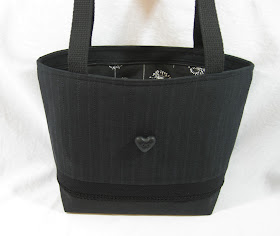After posting the tutorial for scrappy patchwork, my friend Susan (aka
The Sloppy Sewer) tested it out and had some questions. Since another reader asked for a pattern for the red snap pouch, I've decided to present you with another tutorial, with a more detailed explanation of the scrappy patchwork technique, AND directions for the pouch (this time in pink). What more could you ask for?? Here we go!
Scrappy Snappy Pouch Tutorial
Here's what I will make today:
You will need to make a template for your pouch. I use template plastic, like that in the picture below, because it is sturdy, has handy grid lines, and you can lay it over your fabric to check pattern placement. You can buy this at most fabric stores. If you want to use cardboard, that will work too.
Cut a piece of your template material 5 1/2" by 6 1/2". To make the curve at the top, find something circular--I am using a plate with a diameter of 8 1/2".
Find the center of your template material on one of the shorter sides. The arrow marks the center of mine. Line up the edge of your plate (or whatever you are using) with the arrow, and trace the curve. Cut it out on the line and you have your template, which INCLUDES SEAM ALLOWANCE. (I will move the plate right up to the top of the arrow to mark my curve.)
Now, on to the patchwork!
1. Start with scraps that are not too big:
not more than 2-3" wide, not more than 10-12" long. Here you can see that some of my pieces were bigger than that, so I cut them up before sewing. Notice that I cut them at random angles.
You want to avoid 90 degree angles to make it look scrappy.
2. Start sewing pieces together. Sew two pieces together, then iron, then cut a new straight edge along one side, at a funky angle--this straight edge is where you will sew another piece of sewn-together scraps. The section in the center of this picture is what I am starting with. I sewed together the striped and dragonfly pieces, then ironed, cut a straight edge, and sewed on the flower piece.
Here's the same segment, after I've cut the edges straight. Since this is the one I'm starting with, I cut all the edges, so I have lots of areas to choose from to sew on the next piece. After this I will just cut one side at a time; I will choose the piece to sew on based on the size of the piece and color/pattern placement.
Here I've added another section of pieced-together scraps, ironed the seam flat, and now I'm cutting a straight edge. YES, you will end up cutting off a lot of fabric to make the edges straight! That's okay--it means you're doing it right! (I know it's ironic that you will generate a lot of scraps while using your scraps to make this scrappy fabric! Don't worry about it! Sometimes those pieces can be sewn to a different side later.)
3. As the pieced fabric gets bigger, use your template to check it from time to time. This will help you decide which area to use for the front of your pouch, and where to sew on more fabric. I need to do some more sewing!
(You can use narrower seams than usual when piecing together your scraps; one-eighth of an inch is not too narrow, if you can manage it, and it will reduce the bulk on the back of your fabric.)
4. Okay, now my fabric is big enough to make the pouch. The template includes the seam allowance, so just trace around it with pencil, and cut on the pencil line.
5. You will need two more fabrics:
--pouch bottom-front, cut 5 1/2" x 3 3/4"
--pouch lining, cut 6" x 10 1/2" (I like to cut my lining a little bigger to avoid disaster when sewing!)
Sew the bottom-front fabric to the patchwork fabric, right sides together, on the shorter straight edge.
6. Iron on some fusible interfacing to give the fabric body. I use Pellon featherweight fusible. I am also going to use sew-in interfacing (again, I use Pellon, any weight will do--I used a scrap I had laying around). Here, my inner and outer fabrics have interfacing ironed onto the back; in the middle is the sew-in interfacing.
7. Layer everything like this:
--sew-in interfacing on the bottom
--lining fabric, face up, in the middle
--patchwork fabric, face down, on top
Pin together, and sew a 1/4" seam around the perimeter, leaving a 2" opening on one side (in the picture I'm pointing to the best place for the opening).
8. Trim your seams down to 1/4"; turn right-side out through the opening, and iron flat. Then fold up the bottom-front section (the solid pink section) and iron a good crease there. You can see the crease in the picture.
9. Sew the pouch together with a single line of stitching, starting at the bottom front corner, sewing up the side, around the curve, and down the other side to the other bottom front corner (don't stitch along the bottom edge). Back stitch at the beginning and ending of sewing.
10. Iron the front curved section down, add a snap, and you are done!
Which one do you like best?

I'm still offering an envelope of scrap fabric! Just do two little things:
1. Leave a comment below, it can be about anything.
2. Click on my name at right to find the link to my e-mail. Send me an e-mail with your mailing address, color choice for scraps, and Craftster username (if you are active on
Craftster ).
I will send you some scraps ASAP, to get you started on your own scrappy project! (That's right--this is a free offer!)



































































